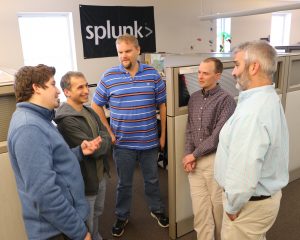In the fifth post of a Getting to Know series about ITS Middleware Services, the Middleware team shares statistics that enlighten us about the use of Splunk at UNC-Chapel Hill. The group also outlines the ways that it is expanding the Splunk community on campus. In addition, Splunk users share their thoughts about Splunk.
To learn more about Splunk, watch Splunk team member Dave Safian discuss the tool in a Splunk company-produced video.

In the fourth post of this Getting to Know series, Middleware Services Manager Patrick Casey introduced us to Splunk. He explained what it is, why ITS uses it and where the University is headed in its use of the system.
The Middleware series launched with Casey, in a Q&A, explaining what Middleware is, why the team has been growing and what the group is working on. In the second post of the series, you can find a list of some of Middleware’s key service offerings. A third post detailed important changes to Middleware’s CloudApps platform.
5 stats for Splunk at ITS
- 34,158 average daily Splunk searches
- 25 billion searchable events
- 3,000 different inputs
- 600 users
- 13 campus entities
What campus users are saying about Splunk
 Sharron Bouquin, Auxiliary Applications Manager, ITS Enterprise Applications: “My team utilizes Splunk to analyze, monitor and alert. We rely heavily on Splunk and could not do our job as effectively without this ‘enabler’ tool, providing a view of numerous logs with events logically grouped and sorted by date/time.”
Sharron Bouquin, Auxiliary Applications Manager, ITS Enterprise Applications: “My team utilizes Splunk to analyze, monitor and alert. We rely heavily on Splunk and could not do our job as effectively without this ‘enabler’ tool, providing a view of numerous logs with events logically grouped and sorted by date/time.” Jim Gogan, Assistant Vice Chancellor, Communication Technologies: “Through Splunk, ridiculous amounts of seemingly unrelated data can actually give us meaningful views into our world, limited only by our imagination and storage.”
Jim Gogan, Assistant Vice Chancellor, Communication Technologies: “Through Splunk, ridiculous amounts of seemingly unrelated data can actually give us meaningful views into our world, limited only by our imagination and storage.” Thomas Jones, Information Security Specialist, Information Security Office: “Splunk allows me to consolidate multiple tools into a single repository yielding up to a 70 percent time savings in processing firewall requests. The business case is obvious; the use case is practical; and the value to the organization is unparalleled. The only remaining question is how we expand this service.”
Thomas Jones, Information Security Specialist, Information Security Office: “Splunk allows me to consolidate multiple tools into a single repository yielding up to a 70 percent time savings in processing firewall requests. The business case is obvious; the use case is practical; and the value to the organization is unparalleled. The only remaining question is how we expand this service.”A customer case study
Read ITS Middleware Services’ case study in which the group explains why it adopted the platform, how Splunk value drives widespread adoption and how dashboards deliver business insights at a glance. Middleware’s success story can be found on the website of Splunk, the company.
Ways ITS Middleware is expanding the Splunk community on campus
- Organized half-day training sessions on campus with technical experts from Splunk, the company
- Created a Splunk opt-in mailing service.
- Launching a quarterly meetup consisting of a brief presentation and an open forum
- Established a digital collaboration space
Reach the Splunk team at splunk@unc.edu or @UNCSplunk on Twitter.
